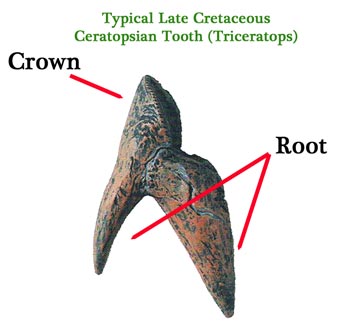Studying the Jaws of Plant-Eating Dinosaurs
Evolution of the Ornithischian Jaw
The earliest plant-eating dinosaurs from the Triassic geological period had thick teeth covered with enamel. More advanced herbivores that evolved in the Jurassic and the Cretaceous had enamel on one side of the tooth only. As the teeth from the upper and lower jaws ground up the tough plant material, the softer side of each tooth wore down more quickly. This made the teeth, effectively, self-sharpening. The teeth were also ever-growing and ever-replacing. Mammals such as ourselves only have a few sets of teeth in lifetime, dinosaurs were able to constantly replace teeth that had been broken and shed from the jaw.
A Tooth from a Triceratops (Late Cretaceous Plant-Eating Dinosaur)
Picture credit: Everything Dinosaur
The strongly rooted teeth of ceratopsian dinosaurs were very efficient teeth for grinding up plant material. The beak on the front of the jaw grabbed the plant material and the teeth towards the back of the jaw ground down the tough plant material.
Everything Dinosaur stocks a wide range of plant-eating dinosaur models, including horned dinosaurs (ceratopsians).
Visit the models section of the company’s award-winning website: Models of Plant-eating Dinosaurs.


